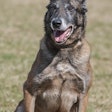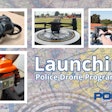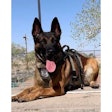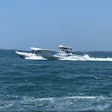Lessons learned from one chaotic experience may help protect you, your fellow officers and your community from injuries, damage or worse.
Any department, in any city in the United States, either has experienced or may experience a situation when otherwise law-abiding citizens become lawless, out-of-control fans.
Such a circumstance, if not properly prepared for, can be a nightmare for local law enforcement.
This report, based on our experiences in Tuscon the past two years, may well assist you in avoiding unexpected chaos with major problems such as injuries to officers and citizens alike, looting and other crimes, damage to public and private property, and even deaths.
Concerns Began Early
On March 31, 1997 the University of Arizona men's basketball team as living a dream. They were playing in the final contest against the overwhelmingly favored team Kentucky. Just a few short weeks before, the oddsmakers had determined them to be 40-1 underdogs to win the NCAA championship. As they continued to win games, the fever pitch began rising among the fans in Tuscon. The media began hyping the team at every opportunity. They even began their broadcasts from sports bars on Tuscon's downtown Fourth Avenue.
Visions of other cities that had won major sports championships started registering in the minds of police administrators. Looting, vandalism, and brawls were common in many cities, in the recent past, that had garnered sports crowns. Could it happen here? Many were sure that it would not. They could not imagine the good citizens of Tuscon acting like animals.
Just prior to the Final Four weekend all the patrol commanders gathered to review the tenants of incident command. An operations plan was established to allow for allocation of the available resources. Contingency plans were discussed and coordination was made with the fire department, sheriff's department, highway patrol, and the UA Police Department. Additional officers were put into position and likely trouble spots were anticipated.
When the first game of the Final Four was won, the crowds were exuberant but controlled. They obeyed the orders of the officers and maintained their composure. This lured some into the feeling that we would be spared. When it was necessary to plan for the final game, there was some dissension concerning the number of officers considered for special deployment. It was finally decided to deploy 17 commanders, 19 sergeants and 133 officers. This is a very considerable number of officers in a force of 870, for a community of 460,000.
"A Very Powerful Hurricane"
From the time the final game began at 5 p.m., until the final whistle, shortly after 10 p.m., the streets were deserted, the bars were packed but under control. The fire department had been out early to ensure compliance with capacity limits. The atmosphere was surreal but little did we know we were in the eye of a very powerful hurricane, about to unleash its power.
When the seconds ticked down to zero, a tremendous energy force was unleashed. The bars along Fourth Avenue erupted and the street quickly began filling with thrilled and intoxicated fans. The pilot in the police helicopter reported thousands of college students on the move from their dorm rooms to the Fourth Avenue area only a few blocks away.
Not helping matters were the media reports that evening, suggesting to fans the THE place to be was on Fourth Avenue. The officers in the area were quickly overwhelmed. Any hope of keeping the fans out of the street quickly evaporated. They then began climbing signs, light poles and on top of businesses. Several even began climbing a highwire tightrope act on the Fourth Avenue trolley lines.
The lack of swift police action to stop these acts caused others to follow suit. The media was everywhere with their television cameras and lights, only adding to the frenzy that was being whipped up by the growing crowd dynamic. Several unruly fans then overturned and looted an unmarked police car. Rocks and bottles damaged six other police vehicles. Restraint continued to be shown by the officers due to the number of decent fans of all ages who just wanted to celebrate.
This restraint, however, apparently urged others to grow wild and defiant. A number of males and females stripped totally naked and began running through the crowds. Traffic on two major thoroughfares was literally stopped. At several intersections along those streets, crowds up to 200 college-age fans began tearing up street signs and destroying traffic signals. Many more officers were now called into action bringing the number of officers deployed to 300.
The sheriff's department offered help and contributed 60 deputies, which was one-third of their entire patrol contingent. Officers and deputies were moved as quickly as possible to the troubled intersections and literally cleared the crowds with the use of O.C. spray, with as few as 10 officers to 200 fans.
Just after 1 a.m., when the bars closed, the mood began to turn ugly on northern Fourth Avenue. A crowd of several hundred had gathered and began pelting officers and deputies with rocks and bottles. A contingent of SWAT officers and canine units were rushed to the area. The officers fought back with O.C. and C.S. gas. They deployed "stingball" grenades, Sage gun rounds, and more than 60 high-impact flex baton rounds fired from shotguns. The remnants of the disturbance were finally cleared by 2:30 in the morning.
The fallout?
One officer had to go to the hospital with a mild concussion from a rock. Several deputies received bumps and bruises. There were several minor injuries to fans and damage was basically minimal.
How Did We Do?
Were we successful? If success could be measured in the end result, the answer would be yes. The vast majority of the officers deployed in this incident had no crowd control training. A combination of their individual actions, the efforts of a few commanders, personal resolve, and the ability to adapt and react was what ended this disturbance in 1977.
The media was extraordinarily effusive in its praise for the actions of the officers. Letters to the editors were filled with disgust for the actions of the few who caused the problems. One UA English student wrote, "The restraint shown by the police made be proud. It is a sad comment on the behavior of the crowd that it was necessary to use tear gas, but considering the violence and vandalism which was occurring, the actions of the police were both justified and necessary."
Television reporters were also quick with praise for the efforts of the officers. Some of the fans had descended upon them also and vandalized their vehicles, stole equipment, and broke a bottle over the head of one cameraman. The ABC affiliate reporter, Christine Lee, signed off with the comment, "There is a fine line between reveling and rioting, and some people crossed it."
Objective Analysis
A critical evaluation had to be made after this incident. Had the commanders of our agency given our officers every chance to succeed? Officers were encouraged to make their comments known about what went right and what went wrong. All too often, after this type of action, commanders will congratulate themselves, give a sigh of relief, and be pleased they "dodged the bullet."
Problems were found in many areas and many recommendations were made for improvements. These recommendations are useful for any department that is faced with the possibility of encouraging this type of event. These guidelines will be enumerated under the Incident Management format.
Command
While the operations plan included specific responsibilities for individual commanders and supervisors, there was a noticeable failure to fully understand all of the roles, specifically in the area of strategic and tactical responsibility.
Recommendation: All personnel receive continuous training and updates in the Incident Management System. Commanders must have more intense training in this area and should be tested on their understanding. The Incident Management System must be utilized in the planning of any major service.
Liaison personnel from other agencies were essential.
Recommendation: If an operation can potentially include any other area agency, they should be consulted before the operation and asked to send a representative. That representative should be a command officer with the authority to deploy resources.
The media had a major impact on this event. Their continual broadcasts from certain bar areas of the city encouraged the crowd to make that area the magnet for its activities. The police department has an openness with the community and the media that must be fostered so that they provide a balanced portrayal of the event.
Recommendation: The role of the public information officer cannot be understated. The PIO should review a major event with representatives of all of the media involved to determine how this relationship can be improved. All commanders and supervisors must understand the role of the media in an event and how their actions can be controlled.
Strict radio communication must be maintained. Only commanders should be utilizing the radio. They must be on one frequency for the event. The reason for this is to control the available resources. With all commanders monitoring the event, they can determine if it would be possible to free up some of their resources to assist in another "hotspot." There was an obvious need, however, to have an administrative frequency where officers or supervisors could switch to for logistical support.
Recommendation: If the support staff is available, have two dispatchers working the individual event. One would maintain control over the command frequency and the other would cover the logistical frequency.
Officers left their helmets in their vehicles and when the crowd grew is size is was difficult for them to get back and retrieve them. There was also one officer who was alone in a prisoner of war van.
Recommendation: In a crowd situation, no officers should ever be without a partner. They should also retain their helmets with them and not count on time to go back and pick them up.
Operations
There was no major staging area designated.
Recommendation: When the size of the event is determined, a staging area must be named. A staging area manager must also be appointed. That manager should be documenting every person who arrives at the staging area, give the person a briefing and an assignment, and also maintain contact with the command post.
Strategic decisions as to the type of munitions allowed to be used were never communicated to the individuals deploying them. The command post must be notified when munitions are utilized in order to coordinate with medical support.
Recommendations: Guidelines must be established before an event. Reporting procedures must also be put into place.
There was a significant lack of training and equipment for the vast majority of officers who were deployed.
Recommendation: Develop the Mobile Field Force approach to civil disturbance and train all of our officers. Work to ensure cooperative efforts with area agencies. Work with the military to locate ballistic helmets, face shields, and gas masks.
While the helicopter was almost indispensable for this event, it is important to have a tactically minded commander to assist in determining courses of action.
Recommendation: Assign a commander to the helicopter and investigate the possibility of a video uplink, which will provide "real time" transmissions of actual events.
Bicycle officers and motor officers were used in police vehicles. At the same time there was gridlock on several major streets due to the size of the disturbance.
Recommendation: Keep the officers on their bicycles and motorcycles to enhance the available options for deploying to trouble spots when police cars cant' get through the gridlock. Also useful for traffic control maneuverability.
Briefings held were inadequate. All personnel must know "rules for engagement" and be updated on mass arrest procedures.
Recommendation: Thorough briefings are essential and a briefing sheet that covers those points should be part of the operations plan so that everyone receives the same information.
It was already noted that every commander must receive better instruction on incident management. One ineffective commander can cripple a plan of action and have the subsequent effect on all subordinates.
Recommendation: Mandate continuous training for all commanders and highly consider the utilization of appointed leadership as opposed to operational leadership. The idea is that there are some commanders who are better leaders than managers and vice versa. Just because a person happens to be in a certain position at a certain time, it may be advantageous to allow a better manager to oversee logistical support and a better leader to be in charge of a dynamic mobile field force. This can be quite controversial and it needs to be determined as a matter of policy.
It was noted that there were a number of incidents of lawlessness such as climbing of buildings, trolley lines, and the destruction of vehicles. There was no immediate action by officers.
Recommendation: This activity must be stopped as soon as it starts. A squad of officers should be deployed to the location and make a statement that these types of violations will not be tolerated. Their action should be to isolate the individuals and deal with the problem.
Logistics
The performance in this area was wholly inadequate. Officers did not have access to water or toilet facilities for hours.
Recommendation: There is a need to formally train a core group of commanders and supervisors to learn this function and where to immediately find available resources. It is vital to the success of any operation.
Identification of supervisors and commanders was difficult, as was the identification of officers from the air.
Recommendation: Standardize helmet marking on the backs of helmets. Suggest that officers wear reflective vests while in the crowds. This had the added advantage of visibility from the air in addition to the crowd instantly recognizing the presence of officers.
Prepare for the jamming of the frequency or the loss of all communication.
Recommendation: Have alternate frequencies named in the operations plan. Have phone numbers to the command note also posted.
Prisoner transport locations and medical evacuation areas were not planned for.
Recommendation: Determine those locations ahead of time and note them for all briefings.
Planning-Finance
A fair attempt was made to establish an initial list of officers present but as the deployment grew, the confusion of who actually was present also grew.
Recommendation: Ensure the appointment of a staging area and a manager at that location to keep an accurate roster of personnel.
Intelligence officers were utilized to look for gambling operations and liquor law offenses.
Recommendation: These officers would be much more valuable determining the crowd dynamics and identifying violators.
Officers were supposed to report injuries and arrests. This was not done nor were proper arrest procedures followed.
Recommendation: Ensure an adequate plan is made for mass arrests. Any officer who utilizes less-lethal or chemical munitions, or makes an arrest should be required to complete a report.
Summary
Considering the preparation time for this particular event, the response by the officers was exemplary. The many recommendations should be a "wake-up call" to all commanders to make immediate improvements. All police departments should make periodic reviews of their operational plans for major events and take advantage of the mistakes or improper planning of other agencies to improve their own response. They owe this to their officers and the citizens of their individual communities.
Capt. Kevin Danaher is a 17-year veteran with the Tuscon Police Department. The graduate of the U.S. Military Academy at West Point is a former Army Major and SWAT commander. He is currently assigned as a patrol division commander and is an occasional contributor to POLICE.












